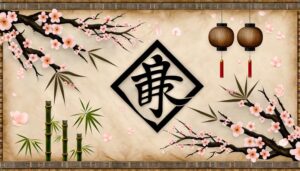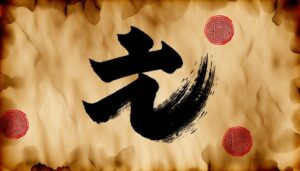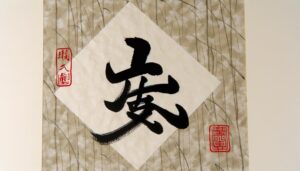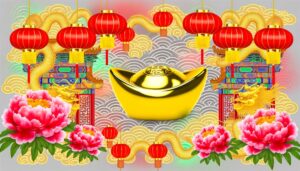What Is the Chinese Year of the Snake Symbol?
The Chinese symbol for the Year of the Snake is 蛇 (shé). This character holds deep cultural, historical, and astrological significance.
Within Chinese mythology, the snake symbolizes wisdom, mystery, and transformation, reflecting sagacity and renewal. It represents the Earth element and is esteemed in the Chinese zodiac for its associations with discretion, resilience, and intellectual prowess.
Celebrations, such as Lantern Festivals, honor the snake's attributes, emphasizing wisdom and guidance. Additionally, figures like Mahatma Gandhi, born in the Year of the Snake, illustrate the snake's influence on societal developments.
Discover more about the snakes' pivotal role in culture and history ahead.
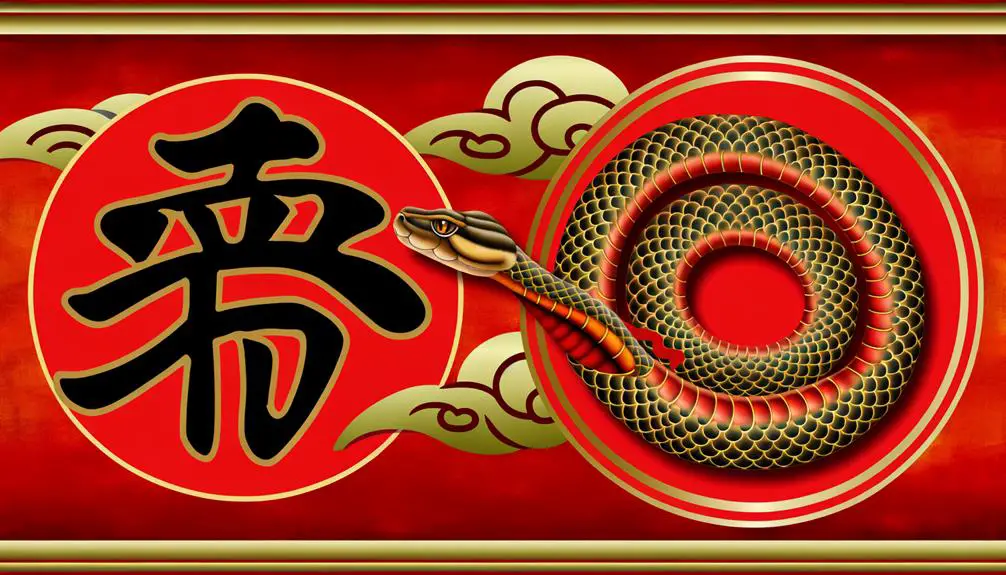
Key Takeaways
- The Chinese symbol for the Year of the Snake is 蛇 (Shé).
- The Snake represents wisdom, mystery, and transformation in Chinese culture.
- Snakes are associated with the Earth element and artistic refinement.
- Celebrations include Lantern Festivals and special foods symbolizing renewal.
- The Snake year is linked with wisdom, discretion, and intellectual prowess.
Origins of the Zodiac

The origins of the Chinese Zodiac, a system deeply ingrained in East Asian culture, can be traced back to ancient astronomical practices and mythological narratives that have evolved over millennia.
Initially used for calendrical purposes, the Zodiac system is based on a 12-year cycle, each year represented by a specific animal sign: Rat, Ox, Tiger, Rabbit, Dragon, Snake, Horse, Goat, Monkey, Rooster, Dog, and Pig.
This system is closely linked to the Chinese lunar calendar and agricultural cycles. Through comparative studies, it is observed that similar systems exist in other Asian cultures, such as the Vietnamese and Thai Zodiacs, reflecting regional variations yet sharing underlying principles.
The Zodiac's cultural context provides insight into values, characteristics, and societal norms associated with each animal sign.
The Snake's Mythology
Rooted deeply in ancient Chinese folklore, the mythology surrounding the Snake in the Zodiac is rich with narratives that depict it as a symbol of wisdom, mystery, and transformation. Historical texts and oral traditions often align the Snake with sagacity, drawing parallels to the revered figure of Fuxi, a legendary culture hero who is depicted as half-human, half-snake.
In these tales, the Snake's ability to shed its skin is emblematic of renewal and metamorphosis, resonating with themes found in Daoist philosophy. Comparative studies reveal that similar to the Greek Ouroboros, the Snake in Chinese culture encircles concepts of cyclical time and continuity.
This intricate tapestry of mythology underscores the Snake's esteemed position in the Chinese zodiac.
Symbolic Meanings
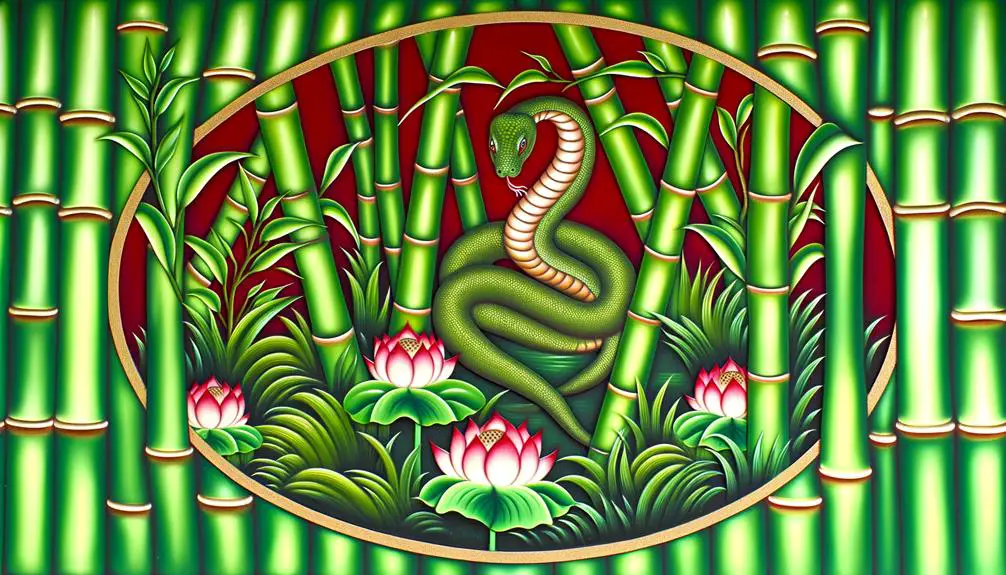
The symbolic meanings of the Year of the Snake encompass a rich tapestry of ancient cultural significance and modern interpretations.
Historically, the snake has been revered in Chinese mythology as a symbol of wisdom, intuition, and transformation.
In contemporary times, this symbol continues to evolve, reflecting various societal values and psychological insights, thereby bridging traditional beliefs with current perspectives.
Ancient Cultural Significance
In ancient Chinese culture, the symbol for the Year of the Snake carries profound meanings that encompass wisdom, transformation, and introspection. This association is rooted in the snake's ability to shed its skin, symbolizing renewal and the cyclical nature of life.
Historically, the snake has been revered for its agility and strategic prowess, qualities that were prized in Chinese society. Comparative studies with other ancient cultures, such as the Egyptian reverence for the serpent as a guardian of sacred spaces, reveal a shared understanding of the snake's mystical attributes.
In Chinese mythology, the snake is often depicted as a powerful yet enigmatic creature, embodying both caution and cunning, which underscores its dual role as a symbol of danger and protection.
Modern Interpretations
Modern interpretations of the Chinese symbol for the Year of the Snake reveal a nuanced blend of traditional values and contemporary perspectives, reflecting its enduring relevance in today's cultural and social contexts.
Historically associated with wisdom, introspection, and transformation, the Snake now embodies modern themes such as adaptability and strategic thinking.
In contemporary Chinese society, the Snake's symbolism extends to personal growth and technological advancement, mirroring the dynamic nature of modern life.
Comparative studies highlight that while the core attributes—caution, elegance, and insight—remain intact, their application has evolved, aligning with globalized cultural narratives.
This fusion of old and new safeguards the Snake symbol's continued resonance, offering a rich tapestry of meanings that bridge past heritage and present-day aspirations.
Historical Significance
Throughout Chinese history, the symbol for the Year of the Snake has been imbued with profound cultural and astrological significance, reflecting its revered status in various dynastic periods. The snake, or 'She,' has been associated with wisdom and intuition, often seen as a harbinger of transformation and renewal. This symbolism has evolved through several historical contexts:
- Han Dynasty: The snake was revered for its association with the Earth element and agricultural fertility.
- Tang Dynasty: It symbolized diplomatic intelligence and strategic thinking, reflecting the era's political sophistication.
- Ming Dynasty: The snake epitomized artistic refinement and elegance, aligning with the flourishing of Chinese art and literature.
These interpretations underscore the snake's multifaceted significance across different historical epochs.
Cultural Representations
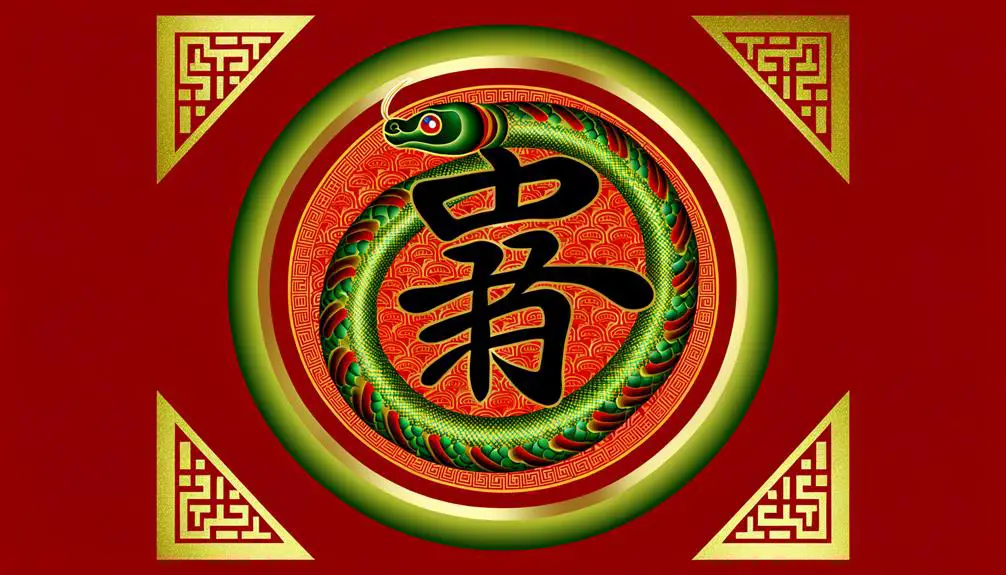
Building on its historical significance, the symbol for the Year of the Snake permeates various facets of Chinese cultural representations. From traditional art and folklore to contemporary media and festivals. Historically, the snake embodies wisdom and transformation, often depicted in folklore as a figure of renewal and cunning.
In contemporary Chinese culture, the Year of the Snake influences zodiac-themed events. Celebrations highlight its traits through performances and decorations. Comparative studies with other cultures reveal similarities in how serpents are revered or feared. Yet in China, the snake uniquely symbolizes intelligence and mystique.
This cultural representation is consistently reinforced through media portrayals and public festivities. Reflecting deep-rooted beliefs and values associated with this enigmatic creature.
Art and Depictions
In Chinese art, the symbol for the Year of the Snake is frequently depicted through intricate calligraphy and vivid imagery, reflecting its profound cultural significance and rich historical context. The artistic representations often showcase the snake's elegance and wisdom, using various media to capture its essence.
Calligraphy: Traditional calligraphy transforms the Chinese character for the snake (蛇) into flowing, dynamic forms, emphasizing the snake's fluidity.
Paintings: Detailed watercolor and ink paintings often portray the snake amidst natural elements, conveying its harmony with nature.
Ceramics and Sculptures: These mediums highlight the snake's coiled form and sinuous movements, symbolizing cyclical renewal and transformation.
Such depictions provide insight into the cultural reverence for the snake, symbolizing intelligence, adaptability, and the continuous cycle of life.
Personality Traits
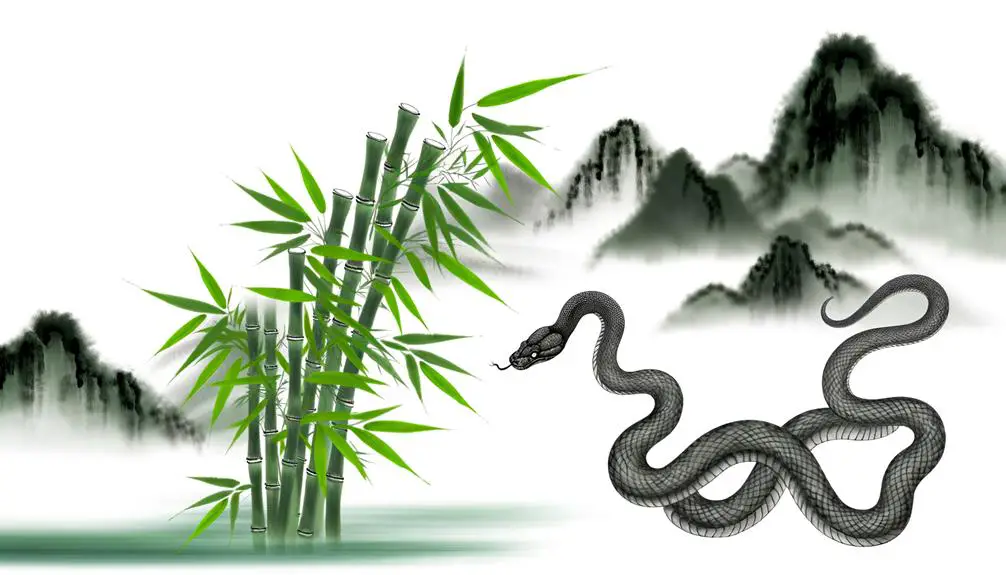
In examining the personality traits associated with the Year of the Snake, one observes a profound blend of mystery and intelligence that is deeply rooted in Chinese cultural symbolism. Individuals born under this sign are often characterized by their secretive nature, wise intellect, and resolute ambition, setting them apart in both personal and professional spheres.
When compared to other zodiac signs, the Snake's unique qualities underscore a distinctive approach to life's challenges, reflecting an intrinsic balance of cunning and determination.
Mysterious and Secretive Nature
The enigmatic and elusive nature of individuals born in the Year of the Snake manifests through their profound intuition and innate ability to navigate complex social landscapes with subtlety and grace. Culturally, this characteristic aligns with traditional Chinese beliefs that associate snakes with secrecy and depth.
Comparative studies reveal three key traits that distinguish those born under this sign:
- Perceptiveness: They have an uncanny ability to sense underlying motives and hidden agendas.
- Discretion: Their actions often go unnoticed, allowing them to operate behind the scenes effectively.
- Adaptability: Much like a snake shedding its skin, they can adapt to changing circumstances with ease.
These attributes make Snakes adept at maintaining an air of mystery while achieving their goals discreetly.
Intelligent and Wise
Renowned for their intellectual prowess and sagacity, individuals born in the Year of the Snake are often celebrated for their ability to synthesize complex information and provide insightful solutions. This characteristic is deeply rooted in Chinese cultural beliefs, where the snake is revered as a symbol of wisdom and strategic thinking. Comparative studies highlight that people born under this sign exhibit a heightened capacity for analytical thought, often excelling in fields requiring meticulous attention to detail. Their intellectual agility allows them to navigate intricate situations with ease, a trait that sets them apart in both personal and professional settings.
| Trait | Description |
|---|---|
| Intellectual | Exceptional ability to understand and process complex information. |
| Wise | Known for their deep understanding and prudent decision-making. |
| Analytical | Skilled in breaking down complicated issues to comprehend underlying themes. |
This nuanced intellect underscores their revered status in Chinese zodiac traditions.
Determined and Ambitious
Building upon their intellectual foundation, individuals born in the Year of the Snake also exhibit an unwavering determination and ambition that drives them to achieve their goals with remarkable persistence. Their pursuit of excellence is deeply ingrained in their cultural heritage, reflecting the snake's symbolic association with perseverance and strategic planning.
Comparative studies of Zodiac signs reveal:
- Long-term Vision: Snakes are known for setting ambitious long-term goals, often excelling in fields requiring sustained effort.
- Strategic Thinking: They meticulously plan their steps, ensuring each action aligns with their ultimate objectives.
- Resilience: Cultural narratives often highlight their capacity to overcome obstacles, drawing strength from their inner resolve.
Understanding these traits offers valuable insights into the character and cultural significance of those born in the Year of the Snake.
Famous Snake Figures
Throughout history, numerous influential figures born in the Year of the Snake have left indelible marks on various cultural, political, and artistic landscapes. For instance, Queen Elizabeth I, whose reign epitomized the Elizabethan era, combined strategic diplomacy with cultural patronage, embodying the Snake's wisdom and charm.
Similarly, Mahatma Gandhi's non-violent resistance movement mirrored the Snake's inherent patience and persistence. In the domain of arts, Bob Dylan, another Snake-born luminary, revolutionized music with his poignant lyrics and social activism. These figures demonstrate how the Snake's attributes—intelligence, intuition, and subtlety—can manifest across different spheres, influencing societal developments and cultural narratives profoundly.
Their legacies offer a comparative study in how the Snake's qualities transcend time and geography.
Celebrations and Traditions

In what ways do the various celebrations and traditions associated with the Year of the Snake reflect the cultural nuances and historical significance attributed to this zodiac sign? The Year of the Snake is celebrated with rituals and customs that emphasize wisdom, mystery, and transformation. These celebrations often reveal deep-seated cultural values and historical contexts.
- Lantern Festivals: Lanterns shaped like snakes symbolize illumination and guidance, reflecting the snake's association with wisdom.
- Family Reunions: Emphasizing introspection, families gather to honor ancestors, mirroring the snake's representation of contemplation.
- Special Foods: Dishes such as snake-shaped pastries signify renewal and transformation, echoing the snake's shedding of skin.
These traditions collectively underscore the snake's revered status in Chinese culture, reinforcing its symbolic significance.
Compatibility With Other Signs
The snake's compatibility with other zodiac signs is deeply rooted in the principles of Chinese astrology. It considers elements like personality traits, elemental influences, and historical symbology to determine harmonious and discordant relationships.
Snakes are often seen as intelligent, enigmatic, and introspective. They find strong compatibility with the Ox and Rooster, who appreciate the snake's wisdom and depth.
Conversely, relationships with the Tiger and Pig can be challenging due to conflicting temperaments. Tigers may find the snake too secretive, while Pigs may perceive them as overly critical.
In comparative studies, the snake's affinity for subtlety and strategy contrasts sharply with more direct signs. This provides a culturally rich framework for understanding interpersonal dynamics within the zodiac system.
Modern Interpretations

Modern interpretations of the Chinese symbol for the Year of the Snake often incorporate a blend of traditional symbolism and contemporary cultural perspectives, reflecting evolving societal values and global influences. This synthesis is evident in various domains:
- Art and Design: Modern artists adapt the snake symbol to fit current aesthetic trends while preserving its historical essence.
- Popular Culture: The snake appears in media and fashion, symbolizing adaptability and strategic thinking in a rapidly changing world.
- Spiritual Practices: Contemporary spiritualists reinterpret the snake's qualities, such as wisdom and transformation, to align with modern self-improvement narratives.
These interpretations provide a comparative lens through which ancient beliefs are recontextualized, offering deeper insights into the ongoing relevance of the Year of the Snake.
Conclusion
The Chinese Zodiac's Snake symbol, steeped in rich mythology and cultural significance, serves as a beacon illuminating the intricate tapestry of historical narratives and symbolic meanings.
This emblem encapsulates both wisdom and cunning, echoing through folklore and modern interpretations alike.
The convergence of ancient traditions and contemporary practices around the Year of the Snake reveals a profound cultural resonance, akin to a timeless melody that continues to play, binding generations together in a shared heritage.

